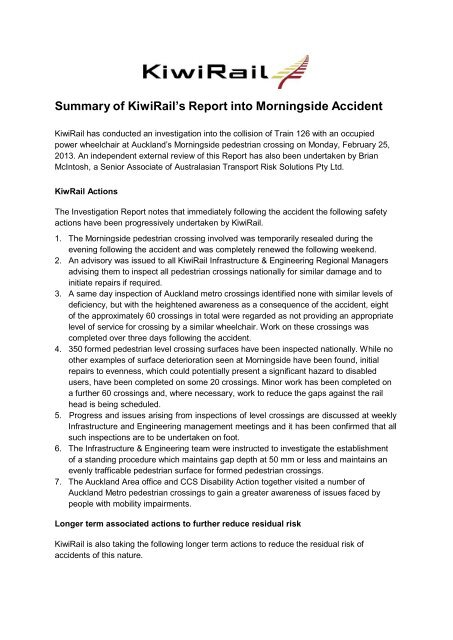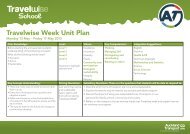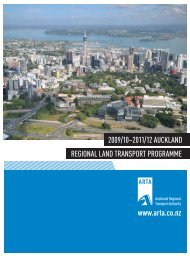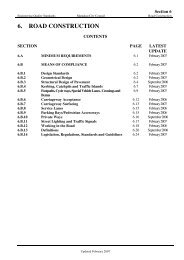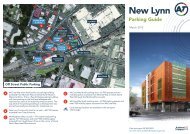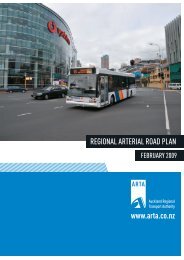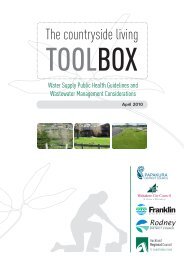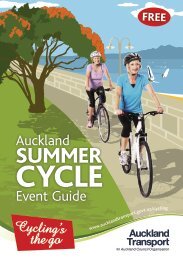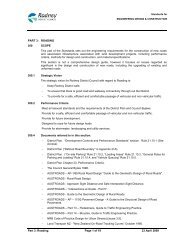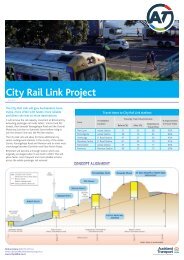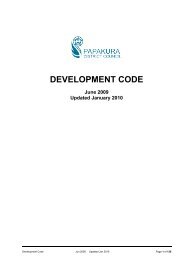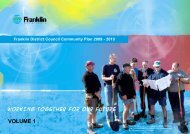Morningside Report and Summary Here - KiwiRail
Morningside Report and Summary Here - KiwiRail
Morningside Report and Summary Here - KiwiRail
Create successful ePaper yourself
Turn your PDF publications into a flip-book with our unique Google optimized e-Paper software.
<strong>Summary</strong> of <strong>KiwiRail</strong>’s <strong>Report</strong> into <strong>Morningside</strong> Accident<br />
<strong>KiwiRail</strong> has conducted an investigation into the collision of Train 126 with an occupied<br />
power wheelchair at Auckl<strong>and</strong>’s <strong>Morningside</strong> pedestrian crossing on Monday, February 25,<br />
2013. An independent external review of this <strong>Report</strong> has also been undertaken by Brian<br />
McIntosh, a Senior Associate of Australasian Transport Risk Solutions Pty Ltd.<br />
KiwRail Actions<br />
The Investigation <strong>Report</strong> notes that immediately following the accident the following safety<br />
actions have been progressively undertaken by <strong>KiwiRail</strong>.<br />
1. The <strong>Morningside</strong> pedestrian crossing involved was temporarily resealed during the<br />
evening following the accident <strong>and</strong> was completely renewed the following weekend.<br />
2. An advisory was issued to all <strong>KiwiRail</strong> Infrastructure & Engineering Regional Managers<br />
advising them to inspect all pedestrian crossings nationally for similar damage <strong>and</strong> to<br />
initiate repairs if required.<br />
3. A same day inspection of Auckl<strong>and</strong> metro crossings identified none with similar levels of<br />
deficiency, but with the heightened awareness as a consequence of the accident, eight<br />
of the approximately 60 crossings in total were regarded as not providing an appropriate<br />
level of service for crossing by a similar wheelchair. Work on these crossings was<br />
completed over three days following the accident.<br />
4. 350 formed pedestrian level crossing surfaces have been inspected nationally. While no<br />
other examples of surface deterioration seen at <strong>Morningside</strong> have been found, initial<br />
repairs to evenness, which could potentially present a significant hazard to disabled<br />
users, have been completed on some 20 crossings. Minor work has been completed on<br />
a further 60 crossings <strong>and</strong>, where necessary, work to reduce the gaps against the rail<br />
head is being scheduled.<br />
5. Progress <strong>and</strong> issues arising from inspections of level crossings are discussed at weekly<br />
Infrastructure <strong>and</strong> Engineering management meetings <strong>and</strong> it has been confirmed that all<br />
such inspections are to be undertaken on foot.<br />
6. The Infrastructure & Engineering team were instructed to investigate the establishment<br />
of a st<strong>and</strong>ing procedure which maintains gap depth at 50 mm or less <strong>and</strong> maintains an<br />
evenly trafficable pedestrian surface for formed pedestrian crossings.<br />
7. The Auckl<strong>and</strong> Area office <strong>and</strong> CCS Disability Action together visited a number of<br />
Auckl<strong>and</strong> Metro pedestrian crossings to gain a greater awareness of issues faced by<br />
people with mobility impairments.<br />
Longer term associated actions to further reduce residual risk<br />
<strong>KiwiRail</strong> is also taking the following longer term actions to reduce the residual risk of<br />
accidents of this nature.
1. Work with other agencies in the development of their long-term (5-10 year) transport<br />
infrastructure plans to ensure that, over time, busy crossings are taken off grade with<br />
over <strong>and</strong> under passes.<br />
2. Ensure those over <strong>and</strong> under passes are effective alternatives for mobility users.<br />
3. Liaise with manufactures of mobility vehicles to try <strong>and</strong> establish improvements to wheel<br />
design to minimize risk at flange gaps. This could include wider wheels <strong>and</strong> or double<br />
wheels.<br />
Investigation Findings<br />
The findings of the Investigation <strong>Report</strong> are as follows:<br />
1. The combination of the uneven surface of the crossing on the day of the accident, the<br />
width <strong>and</strong> depth of the flange gap, <strong>and</strong> the angle of the crossing (which was at 67<br />
degrees to the railway line <strong>and</strong> runners) were major contributing factors to the accident.<br />
2. A number of factors contributed to this situation existing at the time of the accident <strong>and</strong><br />
our findings in that regard are:<br />
• At the highest level, the fact that at-grade pedestrian crossings (as opposed to the<br />
use of under <strong>and</strong> overpasses) continue to be utilised in New Zeal<strong>and</strong> on busy metro<br />
networks meant that this accident was possible.<br />
• No specific consideration was given to the appropriateness of the design of the<br />
pedestrian crossing used at <strong>Morningside</strong> for special needs users such as wheelchair<br />
bound pedestrians, push chair users <strong>and</strong> cyclists. Had such consideration been<br />
made, it may have resulted in a choice of design which may have been less<br />
susceptible to damage <strong>and</strong>/or once damaged, would have posed less of a potential<br />
hazard to wheelchair users. However, had the <strong>Morningside</strong> crossing been<br />
maintained as constructed, the crossing surface would likely not have posed a<br />
potential hazard to wheelchair users.<br />
• There was no specific recognition of potential hazards to special needs users such<br />
as wheelchair bound pedestrians, push chair users <strong>and</strong> cyclists in the maintenance<br />
inspection procedures for level crossings <strong>and</strong> when granting an exemption to the<br />
inspection regime to permit inspections to be undertaken from the cabs of<br />
locomotives, no specific consideration was given to level crossings.<br />
• Once the <strong>Morningside</strong> crossing suffered the water damage, the track inspection<br />
regime did not identify the deteriorated condition of the crossing, it was identified by a<br />
Track Inspector while performing other duties who reported it as requiring work.<br />
• Due to a number of failings within <strong>KiwiRail</strong>’s systems, the remedial work required to<br />
repair the surface of the <strong>Morningside</strong> Crossing was recorded with a lower priority<br />
than intended, the required remedial work was then not undertaken <strong>and</strong> it was also<br />
then incorrectly recorded as having been completed.<br />
Recommendations<br />
The recommendations of the Investigation <strong>Report</strong> are as follows:<br />
1. A review be undertaken of international practice in respect of the design,<br />
construction, inspection <strong>and</strong> maintenance of rail pedestrian crossings. The review<br />
should also include:
a. Consideration of whether (<strong>and</strong> if so in what situations) at-grade crossings<br />
should be used;<br />
b. Consideration of raising the public awareness of the residual risk of at-grade<br />
crossings.<br />
This review should involve representatives of all stakeholders including those<br />
representing special needs users such as wheelchair bound pedestrians, push chair<br />
users <strong>and</strong> cyclists as well as roading authorities <strong>and</strong> other agencies with an interest<br />
in <strong>and</strong>/or responsibility for safety at road/rail crossings.<br />
2. Based on the review, <strong>KiwiRail</strong>’s end to end work processes be reviewed <strong>and</strong> revised<br />
as necessary (including interim measures based on learnings as the review takes<br />
place).<br />
3. A review be undertaken of the code exemption process to ensure it is aligned to the<br />
relevant NRSS risk management approach to changes.<br />
4. A review be undertaken of <strong>KiwiRail</strong>’s processes to ensure work identified as being<br />
required from Inspection reports is properly prioritised, reviewed, logged,<br />
programmed <strong>and</strong> completed.
Rail Level Crossings & Pedestrian Crossings: Further Background<br />
Improving pedestrian safety <strong>and</strong> access for those who are mobility impaired across the<br />
entire national rail network is an on-going process. Specific initiatives when improving or<br />
building new infrastructure that incorporates pedestrian access have included ensuring<br />
pedestrian mazes <strong>and</strong> ramps are wheelchair access compliant, the installation of bells <strong>and</strong><br />
signs for those who are hearing <strong>and</strong> visually impaired at higher risk crossings, <strong>and</strong> the<br />
installation of tactile ground surface indicators.<br />
PUBLIC LEVEL CROSSING COLLISIONS<br />
CALENDAR YEARS 2004 – 2013 (To 18 April )<br />
Vehicle<br />
Pedestrian<br />
33<br />
36<br />
31<br />
23<br />
20<br />
22<br />
16 16 16<br />
4<br />
3<br />
6<br />
7<br />
5 5<br />
2 2 2<br />
2004 2005 2006 2007 2008 2009 2010 2011 2012 2013<br />
Number includes self-harm incidents at designated rail crossings.<br />
Motor Vehicle Collisions<br />
In 2012 there were 16 collisions <strong>and</strong> 139 reported near collisions with motor vehicles<br />
Over the past ten years, there were:<br />
• 244 public road level crossing collisions between road vehicles <strong>and</strong> rail vehicles at<br />
203 different locations – an average of 24 collisions a year.<br />
• Compare this with over 4,000 injury collisions at other road intersections in a typical<br />
year.<br />
Pedestrian Collisions<br />
Over the past 10 years there were:
• 35 collisions between pedestrians <strong>and</strong> rail vehicles at 32 different locations – an<br />
average of 3 – 4 per year. This figure compares with around 300 pedestrian collisions<br />
at road intersections in a typical year.<br />
Where these occurred:<br />
• About 60 per cent of pedestrian level crossing collisions occur at paths alongside<br />
public road level crossings<br />
• About 75 per cent of pedestrian collisions occur where automatic alarms are installed<br />
• About 40 per cent of fatal pedestrian collisions are suicides.<br />
Auckl<strong>and</strong><br />
Significant improvements to the rail network have been made in Auckl<strong>and</strong> over the past six<br />
years as part of the $600 million DART project work carried out. This included the New Lynn<br />
trench which completely removed crossings through a very busy set of road, footpath <strong>and</strong><br />
rail intersections.<br />
All Auckl<strong>and</strong> pedestrian crossings are now fitted with flashing lights <strong>and</strong> bells <strong>and</strong> mazes,<br />
<strong>and</strong> there are automatic gates at at five busy double track st<strong>and</strong>-alone pedestrian level<br />
crossings around the network.<br />
Since September 2006, <strong>KiwiRail</strong> has completed upgrades to 25 level crossings throughout<br />
Auckl<strong>and</strong>. This work has seen:<br />
• Automatic half-arm barriers added to 11 public road level crossings on the Western<br />
Line <strong>and</strong> Onehunga Line.<br />
• Automatic pedestrian gates <strong>and</strong> flashing light <strong>and</strong> bell alarm systems installed at five<br />
busy double track st<strong>and</strong>-alone pedestrian level crossings on the Western Line.<br />
• Flashing light <strong>and</strong> bell alarm systems installed at four st<strong>and</strong>-alone pedestrian level<br />
crossings on the Western Line <strong>and</strong> five pedestrian level crossings on the Southern<br />
Line.<br />
Number of crossings:<br />
• In the Auckl<strong>and</strong> suburban passenger train area i.e. Pukekohe to Waitakere there are<br />
37 road crossings <strong>and</strong> 22 public pedestrian level crossings (59 total).<br />
• In the wider Auckl<strong>and</strong> Council region which includes Mission Bush <strong>and</strong> north to Te<br />
Hana then there are 96 crossings in total, consisting of 24 st<strong>and</strong>-alone pedestrian<br />
plus 72 road crossings.<br />
Infrastructure Spend<br />
The issues identified in this incident are not as a result of any perceived capital shortfall as is<br />
often raised when New Zeal<strong>and</strong>’s rail network is discussed.<br />
The capital expenditure on improving the rail network has been over $2.8 billion since 2006,<br />
not including the major rail upgrade projects in Auckl<strong>and</strong> ($600 million) <strong>and</strong> Wellington ($550<br />
million) that have been completed on time <strong>and</strong> on budget.<br />
As the major renewal projects in Auckl<strong>and</strong> <strong>and</strong> Wellington are finishing we are reverting to a<br />
more normal agreed plan for annual maintenance <strong>and</strong> renewal for rail infrastructure. This
funding will be split according to the use of the infrastructure between metropolitan<br />
Government agencies <strong>and</strong> <strong>KiwiRail</strong>.<br />
On top of this work every year $1 million is spent on major upgrades to level crossings. This<br />
work is prioritised according to the individual risk rating of the 1400 level crossings<br />
nationally. Funds are also spent upgrading level crossings as part of overall infrastructure<br />
improvements, particularly in Wellington <strong>and</strong> Auckl<strong>and</strong>.<br />
Approximately $200,000 is also spent annually on improving rail safety awareness in the<br />
community.<br />
ENDS
COLLISION TRAIN 126 WITH POWER WHEELCHAIR<br />
MORNINGSIDE NORTH<br />
AUCKLAND LINE<br />
MONDAY 25 FEBRUARY 2013<br />
Date of <strong>Report</strong>: 20 April 2013<br />
Investigation Team:<br />
Dennis Bevin<br />
Audit & Investigations Advisor<br />
St<strong>and</strong>ards & Risk<br />
Safety <strong>and</strong> People<br />
<strong>KiwiRail</strong><br />
Ian Cotton<br />
National Manager<br />
St<strong>and</strong>ards & Risk<br />
Safety <strong>and</strong> People<br />
<strong>KiwiRail</strong><br />
<strong>KiwiRail</strong> Review:<br />
Matt Ballard<br />
GM Safety <strong>and</strong> People<br />
<strong>KiwiRail</strong><br />
Andrew Brown<br />
General Counsel<br />
<strong>KiwiRail</strong><br />
Independent External<br />
Reviewer:<br />
Brian McIntosh<br />
Senior Associate<br />
Australasian Transport Risk Solutions Pty Ltd<br />
Iris Incident Reference: 130944<br />
<strong>Report</strong> on Collision Train 126 with Power Wheelchair, <strong>Morningside</strong>, 25 February 2013 Page 1
Table of Contents<br />
Investigation Team:................................................................................................................................. 1<br />
Iris Incident Reference: ........................................................................................................................... 1<br />
Table of Contents .................................................................................................................................... 2<br />
Glossary................................................................................................................................................... 3<br />
Introduction ............................................................................................................................................ 4<br />
What happened? .................................................................................................................................... 4<br />
Train Operation ....................................................................................................................................... 6<br />
<strong>Morningside</strong> Drive Pedestrian Crossing .................................................................................................. 6<br />
What caused the wheelchair to become stuck? ..................................................................................... 7<br />
Design <strong>and</strong> Construction of Crossing .................................................................................................... 10<br />
Inspection of the Crossing..................................................................................................................... 12<br />
Responses of Inspectors ....................................................................................................................... 14<br />
Undertaking the Work .......................................................................................................................... 15<br />
Safety Actions Arising............................................................................................................................ 16<br />
Findings ................................................................................................................................................. 16<br />
Recommendations ................................................................................................................................ 17<br />
Ongoing Investigations ......................................................................................................................... 18<br />
<strong>Report</strong> on Collision Train 126 with Power Wheelchair, <strong>Morningside</strong>, 25 February 2013 Page 2
Glossary<br />
Asset Data Base (ADB)<br />
At-grade rail pedestrian crossing<br />
Auckl<strong>and</strong> Electrification Project<br />
Block of Line (BOL)<br />
Codes <strong>and</strong> St<strong>and</strong>ards<br />
Down Main Line<br />
Flange gap<br />
Field gap<br />
High Rail Vehicles<br />
Loop<br />
Pedestrian maze<br />
Runners (sleepers)<br />
T:200 Network Engineering Track<br />
H<strong>and</strong>book<br />
Turnout<br />
Up Main line<br />
The computerised data base containing work records of<br />
track <strong>and</strong> trackside infrastructure.<br />
A crossing of the railway at ground level (as compared to<br />
grade separated crossings which go over or under<br />
the railway)<br />
Electrification of the suburban rail network within the<br />
Auckl<strong>and</strong> Metropolitan area.<br />
Procedure for blocking a section of railway against the<br />
passage of trains to permit planned work to be<br />
undertaken.<br />
Together with Rules <strong>and</strong> associated documents these<br />
contain <strong>KiwiRail</strong>’s approved processes for the operation<br />
of various related aspects of the railway<br />
network.<br />
The Down Main Line at <strong>Morningside</strong> which carries<br />
trains bound for downtown Auckl<strong>and</strong>.<br />
The gap between the inside of the rail line <strong>and</strong> the<br />
runner of the pedestrian crossing which allows the<br />
passage of wheel flanges.<br />
The gap between the outside of the rail line <strong>and</strong> the<br />
runner of the pedestrian crossing.<br />
A road vehicle fitted with retractable Hi rail wheels such<br />
that it can be driven along the track <strong>and</strong> can also<br />
be on / off tracked at level crossings or other suitable<br />
sites.<br />
The loop line directly connected to a main line provided<br />
for the passing or storage of trains.<br />
A structure consisting of fences which funnel pedestrians<br />
between station platforms <strong>and</strong> over railway tracks.<br />
Wooden sleepers laid parallel to the railway across<br />
asphalt level crossings to deflect vehicle wheels over<br />
the rail head.<br />
A h<strong>and</strong> book for track <strong>and</strong> other staff to have a h<strong>and</strong>y<br />
reference point <strong>and</strong> guide when carrying out track<br />
inspections <strong>and</strong> maintenance work.<br />
Found where railway tracks diverge to control the<br />
direction of trains.<br />
The Up Main Line at <strong>Morningside</strong> which carries trains<br />
travelling from downtown Auckl<strong>and</strong>.<br />
<strong>Report</strong> on Collision Train 126 with Power Wheelchair, <strong>Morningside</strong>, 25 February 2013 Page 3
Introduction<br />
This <strong>Report</strong> records the findings of our investigation into the collision of Train 126 with an<br />
occupied power wheelchair at the <strong>Morningside</strong> pedestrian crossing on Monday 25 February<br />
2013.<br />
The investigation has been undertaken by the incident investigation team within <strong>KiwiRail</strong>’s<br />
Safety <strong>and</strong> People group. This team investigates significant incidents for the purpose of<br />
underst<strong>and</strong>ing what happened <strong>and</strong> to determine whether there are changes that need to be<br />
made in the way <strong>KiwiRail</strong> undertakes its rail activities to better ensure safety.<br />
In carrying out this investigation the investigators reviewed relevant documentation <strong>and</strong><br />
interviewed relevant <strong>KiwiRail</strong> staff <strong>and</strong> members of the public including the two individuals<br />
who went to help. The investigators also spoke with the police officer in charge of the scene.<br />
The investigators’ initial findings were discussed with relevant <strong>KiwiRail</strong> staff <strong>and</strong><br />
management. This <strong>Report</strong> was reviewed by the <strong>KiwiRail</strong> GM Safety <strong>and</strong> People <strong>and</strong> <strong>KiwiRail</strong><br />
General Counsel.<br />
An independent external review of this <strong>Report</strong> has been undertaken by Brian McIntosh, a<br />
Senior Associate of Australasian Transport Risk Solutions Pty Ltd.<br />
What happened?<br />
At about 0906 hours on Monday 25 February 2013, Train 126, a Westfield to Whangarei<br />
express freight service consisting of locomotive DFT7064 <strong>and</strong> 25 wagons with a gross<br />
tonnage of 401 tonnes <strong>and</strong> length of 329 m, collided with an occupied power wheelchair on<br />
the pedestrian crossing over the Up Main Line to Swanson at <strong>Morningside</strong> Drive on the<br />
North Auckl<strong>and</strong> Line.<br />
The operator of the wheelchair, a physically disabled female, had entered the crossing<br />
travelling in an easterly direction. After successfully negotiating the pedestrian crossing over<br />
the loop, she moved on to cross the Up Main Line which ran parallel to the loop.<br />
While doing so, the front caster wheels of the wheelchair became lodged in the flange gap<br />
between the runner (sleeper) <strong>and</strong> the right h<strong>and</strong> rail.<br />
A member of the public went from the platform <strong>and</strong> attempted to free the wheelchair, but<br />
being unable to so, requested assistance from a female passerby who was approaching<br />
from the eastern side of the crossing.<br />
About this time the level crossing alarms activated as Train 126 approached. It appears<br />
that the helpers were eventually able to free the wheelchair’s caster wheels <strong>and</strong> jump clear<br />
themselves, seconds before Train 126, which was under full emergency braking, passed.<br />
As the locomotive passed, the cow catcher struck the wheelchair which was still occupied by<br />
the operator, <strong>and</strong> dragged it about five metres from the point of impact until it was released<br />
just short of the southern abutment of the <strong>Morningside</strong> Up Main Line platform.<br />
The operator of the wheelchair sustained life threatening injuries.<br />
<strong>Report</strong> on Collision Train 126 with Power Wheelchair, <strong>Morningside</strong>, 25 February 2013 Page 4
Figure 1 shows the layout of <strong>Morningside</strong> Drive Level Crossing when viewed from the ramp<br />
leading to the isl<strong>and</strong> platform <strong>and</strong> looking towards Kingsl<strong>and</strong>.<br />
Approach of Train 126<br />
Down Main<br />
line<br />
Pedestrian<br />
maze to isl<strong>and</strong><br />
platform<br />
Up Main line<br />
Direction of travel<br />
of wheelchair<br />
Loop<br />
Figure 1<br />
<strong>Morningside</strong> Drive level crossing looking towards Kingsl<strong>and</strong><br />
Figure 2 shows the layout of <strong>Morningside</strong> Drive level crossing <strong>and</strong> isl<strong>and</strong> platform viewed<br />
from the direction of travel of Train 126 <strong>and</strong> shows the position of the wheelchair.<br />
Position where<br />
wheelchair became<br />
stuck<br />
Direction of travel<br />
of wheelchair<br />
Figure 2<br />
<strong>Morningside</strong> Drive level crossing <strong>and</strong> isl<strong>and</strong> platform<br />
<strong>Report</strong> on Collision Train 126 with Power Wheelchair, <strong>Morningside</strong>, 25 February 2013 Page 5
Train Operation<br />
The locomotive event recorder verification for locomotive DFT7064 confirmed that Train 126<br />
was being driven in accordance with <strong>KiwiRail</strong>’s Codes <strong>and</strong> St<strong>and</strong>ards as the train<br />
approached the pedestrian crossing.<br />
Following the accident the Locomotive Engineer submitted to a drug <strong>and</strong> alcohol test in<br />
accordance with <strong>KiwiRail</strong>’s post incident procedures. The outcome was a “Negative -<br />
Passed Test” result.<br />
<strong>Morningside</strong> Drive Pedestrian Crossing<br />
The <strong>Morningside</strong> Drive pedestrian crossing is located on the North Auckl<strong>and</strong> Line in<br />
S<strong>and</strong>ringham, Auckl<strong>and</strong>.<br />
There are two pedestrian crossings at <strong>Morningside</strong>, one on each side of, but separated from,<br />
the vehicle level crossing.<br />
The crossing traversed three separate tracks as shown in Figure 1, the Down <strong>and</strong> Up Main<br />
Lines <strong>and</strong> the Loop. It also provided access to the isl<strong>and</strong> platform between the Down <strong>and</strong><br />
Up Main Lines.<br />
<strong>Report</strong> on Collision Train 126 with Power Wheelchair, <strong>Morningside</strong>, 25 February 2013 Page 6
What caused the wheelchair to become stuck?<br />
Wheelchair Design<br />
The wheelchair involved in the accident was a TDX SP Wheelchair. These wheelchairs are<br />
imported from the United States of America <strong>and</strong> are distributed in New Zeal<strong>and</strong> by Invacare<br />
(See Figure 3).<br />
TDX SP Wheelchairs weigh 120kg empty <strong>and</strong> are 890mm long <strong>and</strong> 647mm wide. The<br />
wheel arrangement is front <strong>and</strong> rear casters of 147mm diameter with a central drive wheel of<br />
255mm diameter. Suspension is designed to allow for the front casters to travel 36mm up<br />
<strong>and</strong> 36mm down. The caster wheels have a diameter of 147mm <strong>and</strong> a tyre width of 47mm<br />
which extend to 89mm at the axle (See Figure 4). The front caster wheels swivelled<br />
independently as well as moving up <strong>and</strong> down given the suspension of these wheels.<br />
147m<br />
89mm<br />
47mm<br />
74mm<br />
Figure 3<br />
A TDX SP Wheelchair<br />
Figure 4<br />
Caster Wheel Measurements<br />
<strong>Report</strong> on Collision Train 126 with Power Wheelchair, <strong>Morningside</strong>, 25 February 2013 Page 7
The Crossing Surface<br />
The relevant section of the <strong>Morningside</strong> crossing surface consisted of asphalt, wooden<br />
runners (sleepers) positioned parallel to each railway line, field <strong>and</strong> flange gaps <strong>and</strong> rail<br />
tracks.<br />
The width of both the flange gaps was 75mm. The width of the field gaps ranged from<br />
83mm to 98mm (See Figure 5).<br />
At the time of the accident, the surface of the <strong>Morningside</strong> crossing over the Main Lines was<br />
uneven due to the fact that it had suffered premature degradation of the asphalt surface <strong>and</strong><br />
the loss of asphalt from between the rails <strong>and</strong> the runners on either side of the rails. The<br />
surface of the crossing over the Loop had not deteriorated to any extent since the<br />
reconstruction in June 2011, although the gap, runner <strong>and</strong> asphalt construction was the<br />
same as the other crossings. This is in contrast to the deterioration at the Up <strong>and</strong> Down<br />
Main Lines.<br />
Major drainage issues had been reported at the <strong>Morningside</strong> level crossing during heavy<br />
rain. At such times large volumes of water ran downhill from New North Road to fill the only<br />
drain <strong>and</strong> overflow onto the crossing.<br />
In addition, while undertaking excavation work as part of the repair/upgrade work of the<br />
pedestrian crossing following the accident, a break in an Auckl<strong>and</strong> Council water pipe was<br />
discovered almost directly beneath the pedestrian crossing over the Up Main Line.<br />
Extensive amounts of water were found to be lying beneath the crossing <strong>and</strong> also in the<br />
signal cable pits.<br />
The investigation confirmed that the pedestrian crossing on the Up Main Line had been used<br />
as an on / off tracking facility for high rail vehicles during the Auckl<strong>and</strong> Electrification Project<br />
as a normal construction procedure given its proximity to <strong>Morningside</strong> Drive. This would<br />
account for the torn <strong>and</strong> twisted tactile strips shown in Figure 5. Although the seal was built<br />
to vehicle level crossing st<strong>and</strong>ards, it is possible that the weight of these vehicles may have<br />
further contributed to or aggravated the condition of the pedestrian crossing given the<br />
deterioration of the formation beneath the crossing because of the burst water main.<br />
The investigation has concluded that the probable reason for the deterioration of the asphalt<br />
around the Main Lines was water issues. By comparison, the asphalt around the Loop was<br />
not deteriorated to any significant extent because:<br />
1. the break in the water pipe was immediately under the Up Main;<br />
2. the Main Lines are much more heavily used by trains than the loop.<br />
This is significant because the continual passage of trains over the Up <strong>and</strong> Down Main line<br />
crossings would likely have aggravated the conditions occurring beneath <strong>and</strong> would have<br />
further contributed to their deterioration in contrast to the loop which was very seldom used,<br />
<strong>and</strong> then usually only for the storage of train sets during events at Eden Park.<br />
An expert in asphalt engineering has been engaged by the investigation team to give an<br />
opinion on the effect of these factors on the asphalt.<br />
<strong>Report</strong> on Collision Train 126 with Power Wheelchair, <strong>Morningside</strong>, 25 February 2013 Page 8
83mm<br />
75mm<br />
72mm<br />
92mm<br />
Field gap<br />
Direction of Travel of<br />
Wheelchair<br />
Flange gap<br />
Flange<br />
gap in<br />
which the<br />
wheels<br />
became<br />
lodged<br />
90mm<br />
75mm<br />
75mm<br />
98mm<br />
Figure 5<br />
Up Main Line pedestrian crossing at the time of the collision<br />
The wheelchair’s wheels becoming lodged in the gap<br />
The operator of the wheelchair had entered the crossing travelling in an easterly direction<br />
<strong>and</strong> had negotiated the pedestrian crossing over the Loop. As explained above, that section<br />
of the crossing was not in the degraded condition of those over the Up Main Line <strong>and</strong>, to a<br />
lesser extent, the Down Main Line. The surface of the crossing at the Loop was relatively<br />
smooth <strong>and</strong> likely posed no problem to the wheelchair dynamics. The operator of the<br />
wheelchair then moved to cross the Up Main Line crossing.<br />
Interviews with the two helpers stated that the front caster wheels of the wheelchair were<br />
lodged in the flange gap of the right h<strong>and</strong> rail of the Up Main Line. The caster wheels of the<br />
wheelchair were of such a diameter that they could not have fallen into the gap as long as<br />
they faced in the direction of travel. The front caster wheels have a diameter of 147 mm <strong>and</strong><br />
the flange gap was 75mm wide. However, the front caster wheels are 47mm wide <strong>and</strong> to<br />
become lodged, therefore, the wheels must have turned at right angles to the direction of<br />
travel, <strong>and</strong> parallel to the rail, or at angle which was sufficiently acute to cause the wheels to<br />
slide into that position. However, we cannot know for certain the reason why the wheels<br />
became lodged in the gap.<br />
In our view, the width <strong>and</strong> depth of the flange gap, the uneven surface of the crossing <strong>and</strong><br />
the angle of the crossing (which was at 67 degrees to the railway line <strong>and</strong> runners) were<br />
probably major contributing factors. The uneven surface would likely have given rise to<br />
juddering <strong>and</strong> a redistribution of weight, which could have caused the caster wheels to<br />
swivel as the wheelchair moved across that section of the crossing.<br />
Despite the best efforts of the helpers who went to the occupant’s aid, in our view, it is likely<br />
that the weight of the occupied wheelchair would have made it extremely difficult to dislodge<br />
the wheels from the gap. However, the helpers were eventually able to move the wheelchair<br />
from the centre of the track such that the impact of the train deflected the wheelchair to the<br />
right h<strong>and</strong> side of the track. How they achieved this could not be determined.<br />
<strong>Report</strong> on Collision Train 126 with Power Wheelchair, <strong>Morningside</strong>, 25 February 2013 Page 9
Design <strong>and</strong> Construction of Crossing<br />
What do the codes <strong>and</strong> st<strong>and</strong>ards require in terms of design <strong>and</strong><br />
construction of pedestrian crossings?<br />
There are a number of designs used by <strong>KiwiRail</strong> for level crossings which involve different<br />
construction techniques. These include rubber level crossing systems, pre- fabricated<br />
concrete slabs, asphalt without runners <strong>and</strong> asphalt with runners.<br />
In some cases specific pedestrian design plans were available, but for asphalt crossings,<br />
road crossing designs were used. For asphalt crossings two design plans were available,<br />
one for asphalt road crossings without wooden runners <strong>and</strong> one with wooden runners.<br />
For level crossings constructed using asphalt with wooden runners, the wooden runners<br />
were inserted parallel to the outer edge of each rail. The purpose of this was to deflect road<br />
vehicles from impacting on the head of the rail as they passed over.<br />
In crossings of this type, the field gap between the runner <strong>and</strong> the rail in the design was<br />
75mm wide <strong>and</strong> was required to be completely filled with asphalt. The design also included a<br />
75mm flange gap between the inside of each rail <strong>and</strong> the adjacent runner. The flange gap<br />
was necessary so that the wheel flanges of rail vehicles could pass without striking the<br />
crossing surface. The depth of the flange gaps for the type of crossing used at <strong>Morningside</strong><br />
Drive varied from 30mm to 37mm, depending on the size of the rail so that even with wear,<br />
the depth could not exceed 50mm if the crossing was built to plan. The floor of the gaps<br />
required 120mm of asphalt fill down to the supporting sleeper <strong>and</strong> fastenings.<br />
Designs existed for level crossings using the rubber level crossing systems. Where these<br />
were to be used, the Track Engineering Office in Wellington was required to be involved <strong>and</strong><br />
arranged for specifications of the level crossing to be sent to the manufacturer who designed<br />
<strong>and</strong> submitted a drawing specification for the crossing for approval prior to supply of the<br />
rubber panels. In these cases the design drawing was specific to the particular level<br />
crossing they were being designed for. The rubber panels came in lengths of 600mm up to a<br />
maximum of 1800mm. The design flange gap for rubber level crossings was 70mm wide<br />
<strong>and</strong> 50mm deep.<br />
Examples of these crossings had been installed in the Wellington Metro area.<br />
A prefabricated concrete panel design was also available <strong>and</strong> there were several examples<br />
of these in the Auckl<strong>and</strong> Metro area. These designs did not make provision for the filling of<br />
the flange gaps which are consequently full depth.<br />
Construction of the <strong>Morningside</strong> Crossing<br />
The <strong>Morningside</strong> Drive pedestrian crossing had originally been part of the vehicle level<br />
crossing.<br />
In 2011 prior to the Rugby World Cup <strong>and</strong> during the Auckl<strong>and</strong> Rail Network preparation<br />
stage leading up to the Cup, the existing <strong>Morningside</strong> pedestrian crossing layout was<br />
considered to be inadequate for large crowd access / egress. It was decided that it be<br />
upgraded, including the maze layout, to provide more flexibility. Part of that upgrading<br />
included the separation of the pedestrian crossings from the vehicle level crossing. The<br />
crossings were installed over the weekend of 5, 6 <strong>and</strong> 7 June 2011.<br />
The <strong>Morningside</strong> pedestrian crossing was constructed using the asphalt <strong>and</strong> runner road<br />
crossing design.<br />
Alternatives of using either rubber panels or concrete slab inserts were considered.<br />
Concrete slabs were considered unsuitable because of the angle of this pedestrian crossing<br />
to the track (67 degrees) which meant that the three panels required for each of the six<br />
<strong>Report</strong> on Collision Train 126 with Power Wheelchair, <strong>Morningside</strong>, 25 February 2013 Page 10
individual crossings would be staggered which would result in a restricted width pathway in<br />
parts. Continuous pour concrete was not considered as a suitable construction method<br />
because of its tendency to crumble with movement from passing trains <strong>and</strong> the longer<br />
installation period required, over 24 hours.<br />
A rubber panel crossing was considered for the <strong>Morningside</strong> level crossing, however, the<br />
time to procure including design (4 months) was too long to meet the construction timeframe.<br />
The crossing at <strong>Morningside</strong> was therefore built to the specifications applicable to the<br />
construction of an asphalt road crossing as per Track <strong>and</strong> Structures Engineering Group<br />
Wellington Asphalt Road Crossing Drawing CE No 100 405.<br />
The project team had selected this st<strong>and</strong>ard because of its use in other existing pedestrian<br />
crossings in Auckl<strong>and</strong>.<br />
Figure 6<br />
<strong>Morningside</strong> Drive pedestrian crossing after completion of upgrading<br />
June 2011<br />
<strong>Report</strong> on Collision Train 126 with Power Wheelchair, <strong>Morningside</strong>, 25 February 2013 Page 11
Inspection of the Crossing<br />
What do the Codes <strong>and</strong> St<strong>and</strong>ards require in terms of inspections?<br />
Track inspections of the North Auckl<strong>and</strong> Line through <strong>Morningside</strong> were required to be<br />
undertaken by the Track Inspector twice a week <strong>and</strong>, until around 2006, practice was that<br />
they were normally undertaken by Hi Rail Vehicle. These inspections included inspections of<br />
level crossings in accordance with Infrastructure Code Supplement Section 21 Clause 3.2.<br />
This clause stated that Track Inspectors were responsible for off track infrastructure<br />
inspections including:<br />
Level Crossings:<br />
<br />
<br />
<br />
Check road surface condition;<br />
Check flangeway clearances are adequate;<br />
Check signs are correct.<br />
There was no specific mention of pedestrian crossings, as they are encompassed by the<br />
level crossing regime.<br />
Exemptions to this Code could be granted by the Technical Manager responsible for the<br />
Code / St<strong>and</strong>ard where it was proposed that a particular requirement of the Code or<br />
St<strong>and</strong>ard be changed.<br />
A Code Exemption had been issued in May 2009 which permitted track inspections within the<br />
Auckl<strong>and</strong> Metro area to be undertaken from the cab of a locomotive. The Exemption, with<br />
conditions, was granted because traffic density meant that there was insufficient time<br />
between trains to get hi rail vehicles on track for inspection purposes. As a result,<br />
inspections were done from locomotive cabs. Regular extensions to this Exemption had<br />
been issued <strong>and</strong> it was still in place at the time of the accident. The Exemption contained<br />
conditions, including requiring all Turnouts to be inspected on foot on a weekly basis <strong>and</strong> for<br />
any other issues observed during the inspection to be followed up with a ground inspection if<br />
necessary. The Exemption did not contain a condition that level crossings be inspected by<br />
foot.<br />
What inspections occurred?<br />
The condition of the <strong>Morningside</strong> pedestrian crossing had deteriorated at a fast rate since<br />
construction of the crossing in June 2011. The deterioration had not been noticed during the<br />
regular locomotive cab inspections.<br />
However, on 5 September 2012 a Track Inspector while walking within the <strong>Morningside</strong> rail<br />
corridor for the purpose of inspecting the Turnout identified low spots in the surface of the<br />
pedestrian crossings over both Main Lines. He reported his findings on the M125/6 Track<br />
Inspection Form together with the comment “This is a major trip hazard” <strong>and</strong> a<br />
recommendation “Resurface with new hot mix. Both mains”. He also attached a photograph<br />
of the site at that time (see Figure 7, noting that the arrows <strong>and</strong> words were subsequently<br />
added to the photo by the Inspector at the time he submitted his M125/6).<br />
<strong>Report</strong> on Collision Train 126 with Power Wheelchair, <strong>Morningside</strong>, 25 February 2013 Page 12
Figure 7<br />
Condition of <strong>Morningside</strong> Drive pedestrian crossing as reported by Track<br />
Inspector 5 September 2012<br />
The Track Inspector had reported the condition of the asphalt seal between the rails on both<br />
the Down <strong>and</strong> Up Main Lines during a foot inspection, but had not at that time raised either<br />
the lack of fill nor the overall deteriorated condition of the remaining fill in the field <strong>and</strong> flange<br />
gaps on either side of the rails as an issue.<br />
As noted later in this <strong>Report</strong>, no remedial work was undertaken to address the issues raised<br />
by the Track Inspector prior to the accident.<br />
At the end of November or early December 2012 the same Track Inspector had revisited the<br />
site (as part of his Turnout inspections). He was concerned that nothing had been done in<br />
the way of repairs to the crossing so he applied fluorescent paint to mark danger spots for<br />
members of the public using the crossing. Those markings are shown in Figure 5.<br />
<strong>Report</strong> on Collision Train 126 with Power Wheelchair, <strong>Morningside</strong>, 25 February 2013 Page 13
Responses of Inspectors<br />
What do the Codes <strong>and</strong> St<strong>and</strong>ards require in terms of Inspectors’<br />
responses?<br />
Track Inspectors were required to report inspection findings in accordance with Railnet Code<br />
Clause P 26(a) which stated that:<br />
“Track inspections shall be carried out in accordance with Clause P21 & P24 <strong>and</strong> reported on<br />
an approved form to the Line Manager."<br />
In the same way as any other deterioration found during inspection, if the surface of a<br />
crossing had deteriorated, the Inspector would identify what work was required <strong>and</strong> allocate<br />
a priority to that work.<br />
Prioritisation was made based on a T200 St<strong>and</strong>ard which had the following regime: P1=work<br />
required within 2 days, P2= work required within 1 week, P3=work required within 1 month,<br />
P4= work required within 6 months.<br />
Track Code Supplement CSP 22 Issue 2 dated July 2012 contained pictorial guidelines to<br />
help inspectors appropriately prioritise work. It also changed the regime to - P1= work<br />
required within 24 hours, P2= work required within 7 days, P3= work required within 30 days,<br />
P4= work required within 90 days.<br />
CSP 22 was prepared because T200 did not specifically provide a prioritisation regime for<br />
remedial work at level crossings.<br />
CSP 22 only contained guidelines relating to condition assessment of the roadway <strong>and</strong> was<br />
silent on the appropriateness of assessment to walkway surfaces at pedestrian crossings.<br />
CSP 22 was available on the intranet <strong>and</strong> was being progressively introduced at training<br />
updates.<br />
How did the work get prioritised?<br />
The Track Inspector who noticed the condition of the <strong>Morningside</strong> crossing assessed the<br />
priority of the work required as Priority 4 (working under the T200 regime), however, he<br />
believed this equated to repair required in 90 days, where in fact P4 in T200 required the<br />
repair within 6 months.<br />
He was not aware of the existence of CSP 22 Issue 2 because he had not at the time of<br />
reporting attended the Track Inspectors’ Refresher Course at which copies of CSP22 Issue 2<br />
were provided to attendees.<br />
.<br />
<strong>Report</strong> on Collision Train 126 with Power Wheelchair, <strong>Morningside</strong>, 25 February 2013 Page 14
Undertaking the Work<br />
What do the Codes <strong>and</strong> St<strong>and</strong>ards require in terms of undertaking works?<br />
The information from M125/6 Track Inspection report prepared by Track Inspectors which<br />
identifies work required is sighted by the Area Manager, then assessed by the Field<br />
Engineer <strong>and</strong> is then logged into the Asset Data Base (ADB). A summary report (which lists<br />
the work required) is then created from ADB for review by line management (Field Engineer<br />
<strong>and</strong>/or Area Manager) who then schedule the work for the appropriate ganger (being the<br />
person responsible for the team carrying out the work).<br />
Once work is completed, the completed job list is then returned to the Field Engineer who<br />
reviews the list, which is then entered as complete, with the completed date in the relevant<br />
record.<br />
This process is set out in a training document <strong>and</strong> is customary practice but is not codified.<br />
What happened in relation to the works on the Crossing?<br />
The information from the relevant M125/6 Inspection <strong>Report</strong> was entered into the ADB, but<br />
without review by the Field Engineer. When entered into the ADB system, the P4<br />
prioritisation was accorded a six month repair timeframe, not the 90 days as it would have<br />
been in accordance with the initial intention of the Track Inspector or if it had been assessed<br />
as P4 in accordance with CSP22.<br />
A Block of Line was in place during the Christmas 2012 – New Year 2013 period for the<br />
entire Auckl<strong>and</strong> Metropolitan Area for the purposes of continuing major project work in the<br />
absence of trains. The outst<strong>and</strong>ing work listed on the M125/6 Track Inspection <strong>Summary</strong><br />
<strong>Report</strong> dated 21 December 2012 which included the work required at the <strong>Morningside</strong><br />
crossing was to be accommodated within the project-related Block of Line program.<br />
The summary report still showed the work at <strong>Morningside</strong> crossing as a P4 with a 6 month<br />
maximum completion date from initial inspection date of 5 September 2012.<br />
Over the Christmas period the Track Inspector in charge of the maintenance gang (not the<br />
Inspector who had identified the uneven surface) had concentrated his efforts on repairing<br />
EM80 (Track Recording Car) track geometry exceedances recorded on the M125/6 Track<br />
Inspection <strong>Summary</strong> <strong>Report</strong> dated 21 December 2012 <strong>and</strong>, although he had rectified a fault<br />
at the first pedestrian crossing at <strong>Morningside</strong>, he was not equipped or resourced to respond<br />
to the issues raised in the 5 September 2012 M125/6 Inspection <strong>Report</strong> in relation to the<br />
second pedestrian crossing <strong>and</strong> the original 6 months for completion had not yet expired.<br />
The copy of the M125/6 Track Inspection <strong>Summary</strong> <strong>Report</strong> was subsequently endorsed with<br />
the date “29/12/12” signifying that the work had been completed. It was possible that the<br />
Track Inspector had signed off the work on both pedestrian crossings as having been<br />
completed, even though the work had only been completed on one, by mistake. The close<br />
physical proximity of the pedestrian crossings, separated only by the vehicle level crossing,<br />
<strong>and</strong> their proximity on the <strong>Summary</strong> <strong>Report</strong> would tend to support this.<br />
That information was entered into the ADB on 4 January 2013. At that time the TID<br />
reference was transferred as completed from the M125/6 Track Inspection <strong>Summary</strong> <strong>Report</strong><br />
to the ADB Archive (Complete).<br />
<strong>Report</strong> on Collision Train 126 with Power Wheelchair, <strong>Morningside</strong>, 25 February 2013 Page 15
Safety Actions Arising<br />
Following the accident the following safety actions have been undertaken by <strong>KiwiRail</strong>.<br />
1. The <strong>Morningside</strong> pedestrian crossing involved was temporarily resealed during the<br />
evening following the accident <strong>and</strong> was completely renewed the following weekend.<br />
2. An advisory was issued to all I&E Regional Managers advising them to inspect all<br />
pedestrian crossings in their areas for similar damage <strong>and</strong> to initiate repairs if<br />
required.<br />
3. A same day inspection of Auckl<strong>and</strong> metro crossings identified none with similar level<br />
deficiency, but with the heightened awareness as a consequence of the accident<br />
eight of some 60 metro crossings in total were regarded as not providing an<br />
appropriate level of service for crossing by a similar wheelchair. Initial work on these<br />
crossings was scheduled <strong>and</strong> completed over three days.<br />
4. 350 formed pedestrian level crossing surfaces have been inspected nationally. While<br />
no other examples of surface deterioration seen at <strong>Morningside</strong> have been found,<br />
initial repairs to evenness which could potentially present a significant hazard to<br />
disabled users have been completed on some 20 crossings. Minor work has been<br />
completed on a further 60 crossings <strong>and</strong> where necessary, work to reduce the gaps<br />
against the rail head is being scheduled.<br />
5. Progress <strong>and</strong> issues arising from inspections of level crossings are discussed at<br />
weekly Infrastructure <strong>and</strong> Engineering management meetings <strong>and</strong> it has been<br />
confirmed that all such inspections are to be undertaken on foot.<br />
6. The Infrastructure & Engineering team were instructed to investigate the<br />
establishment of a st<strong>and</strong>ing procedure which maintains gap depth at 50 mm or less<br />
<strong>and</strong> maintains an evenly trafficable pedestrian surface for formed pedestrian<br />
crossings.<br />
7. The Auckl<strong>and</strong> Area office connected with CCS Disability Action <strong>and</strong> together visited a<br />
number of Auckl<strong>and</strong> Metro pedestrian crossings to gain a greater awareness of<br />
issues faced by people with disabilities.<br />
Findings<br />
Our findings as to what happened in relation to the accident at <strong>Morningside</strong> crossing on 25<br />
February 2013 are set out in the sections of this <strong>Report</strong> entitled “What happened?” <strong>and</strong><br />
“What caused the wheelchair to become stuck?” In our view, the width <strong>and</strong> depth of the<br />
flange gap, the uneven surface of the crossing on the day of the accident <strong>and</strong> the angle of<br />
the crossing (which was at 67 degrees to the railway line <strong>and</strong> runners) were major<br />
contributing factors.<br />
Based on our investigation, a number of factors contributed to this situation existing at the<br />
time of the accident <strong>and</strong> our findings in that regard are set out below.<br />
At the highest level, the fact that at-grade pedestrian crossings (as opposed to the use of<br />
under <strong>and</strong> overpasses) continue to be utilised in New Zeal<strong>and</strong> on busy metro networks<br />
meant that this accident was possible.<br />
<strong>Report</strong> on Collision Train 126 with Power Wheelchair, <strong>Morningside</strong>, 25 February 2013 Page 16
No specific consideration was given to the appropriateness of the design of the pedestrian<br />
crossing used at <strong>Morningside</strong> for special needs users such as wheelchair bound<br />
pedestrians, push chair users <strong>and</strong> cyclists. Had such consideration been made, it may have<br />
resulted in a choice of design which may have been less susceptible to damage <strong>and</strong>/ or<br />
once damaged, would have posed less of a potential hazard to wheelchair users. However,<br />
had the <strong>Morningside</strong> crossing been maintained as constructed, the crossing surface would<br />
likely not have posed a potential hazard to wheelchair users.<br />
There was no specific recognition of potential hazards to special needs users such as<br />
wheelchair bound pedestrians, push chair users <strong>and</strong> cyclists in the maintenance inspection<br />
procedures for level crossings <strong>and</strong> when granting an exemption to the inspection regime to<br />
permit inspections to be undertaken from the cabs of locomotives, no specific consideration<br />
was given to level crossings.<br />
Once the <strong>Morningside</strong> crossing suffered the water damage, the track inspection regime did<br />
not identify the deteriorated condition of the crossing, it was identified by a Track Inspector<br />
while performing other duties who reported it as requiring work.<br />
Due to a number of failings within <strong>KiwiRail</strong>’s systems, the remedial work required to repair<br />
the surface of the <strong>Morningside</strong> Crossing was recorded with a lower priority than intended,<br />
the required remedial work was then not undertaken <strong>and</strong> it was also then incorrectly<br />
recorded as having been completed.<br />
Recommendations<br />
It is recommended that:<br />
1. A review be undertaken of international practice in respect of the design,<br />
construction, inspection <strong>and</strong> maintenance of rail pedestrian crossings. The review<br />
should also include:<br />
a. consideration of whether (<strong>and</strong> if so in what situations) at-grade crossings<br />
should be used;<br />
b. consideration of raising the public awareness of the residual risk of at-grade<br />
crossings.<br />
This review should involve representatives of all stakeholders- including those<br />
representing special needs users such as wheelchair bound pedestrians, push chair<br />
users <strong>and</strong> cyclists as well as roading authorities <strong>and</strong> other agencies with an interest<br />
in <strong>and</strong>/or responsibility for safety at road/rail crossings.<br />
2. Based on the review, <strong>KiwiRail</strong>’s end to end work processes be reviewed <strong>and</strong> revised<br />
as necessary (including interim measures based on learnings as the review takes<br />
place).<br />
3. A review be undertaken of the Code exemption process to ensure it is aligned to the<br />
relevant NRSS risk management approach to changes.<br />
4. A review be undertaken of <strong>KiwiRail</strong>’s processes to ensure work identified as being<br />
required from Inspection reports is properly prioritised, reviewed, logged,<br />
programmed <strong>and</strong> completed.<br />
<strong>Report</strong> on Collision Train 126 with Power Wheelchair, <strong>Morningside</strong>, 25 February 2013 Page 17
Ongoing Investigations<br />
This <strong>Report</strong> records the investigation to date. Aspects remaining the subject of ongoing<br />
investigation include:<br />
• The external study of the asphalt deterioration issues.<br />
• If there are any wider ramifications of the inspection regime.<br />
<strong>Report</strong> on Collision Train 126 with Power Wheelchair, <strong>Morningside</strong>, 25 February 2013 Page 18


